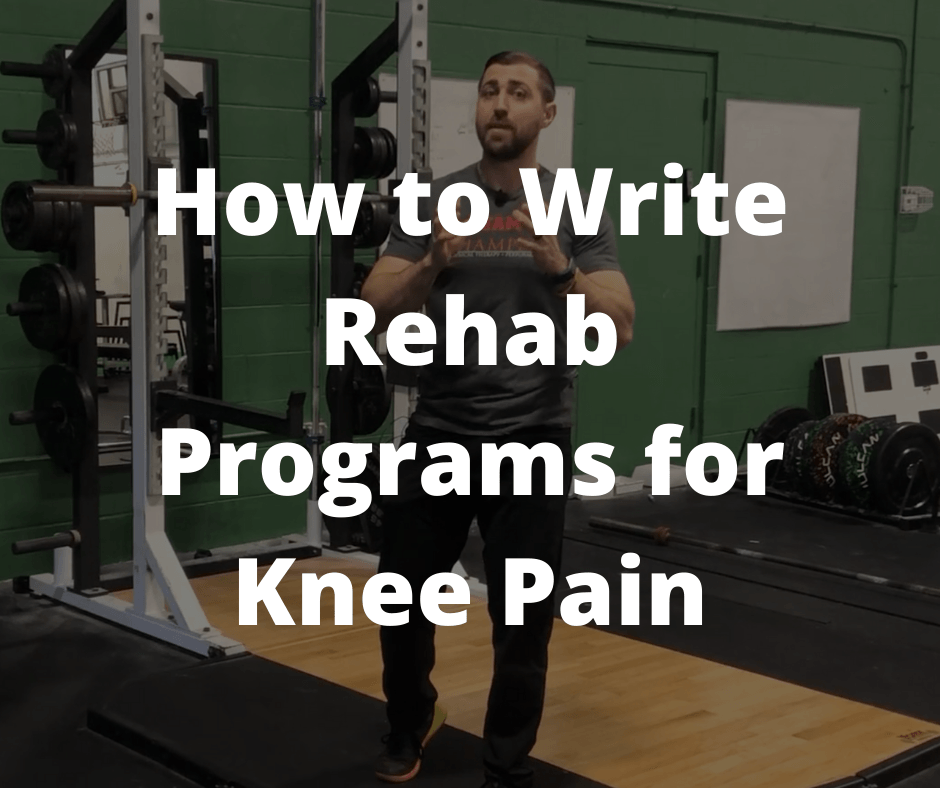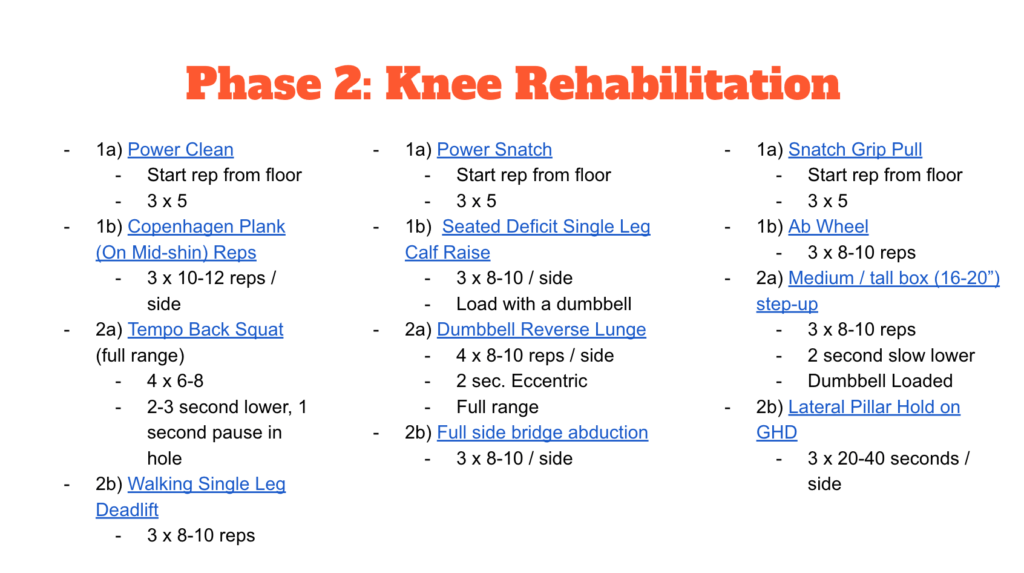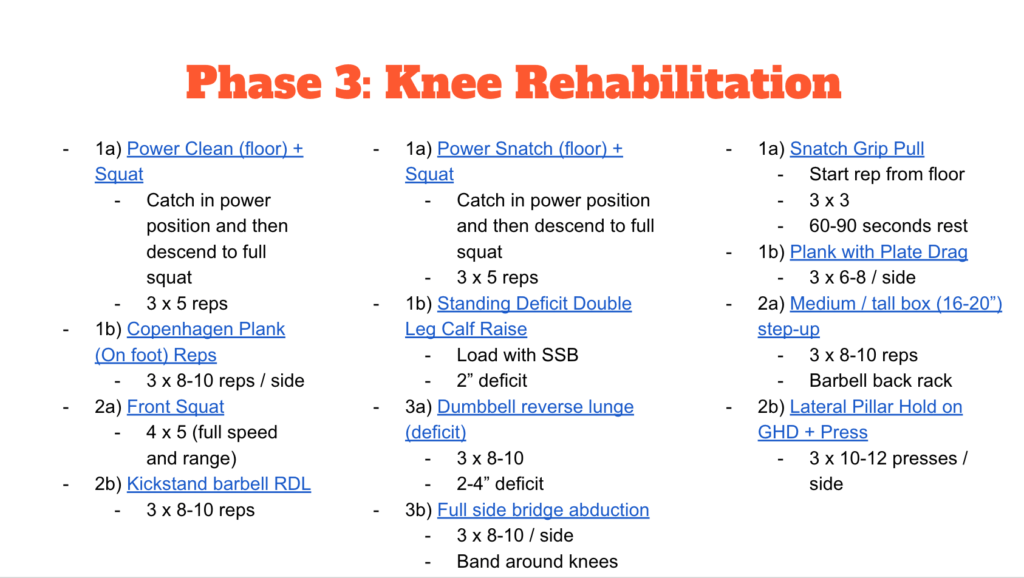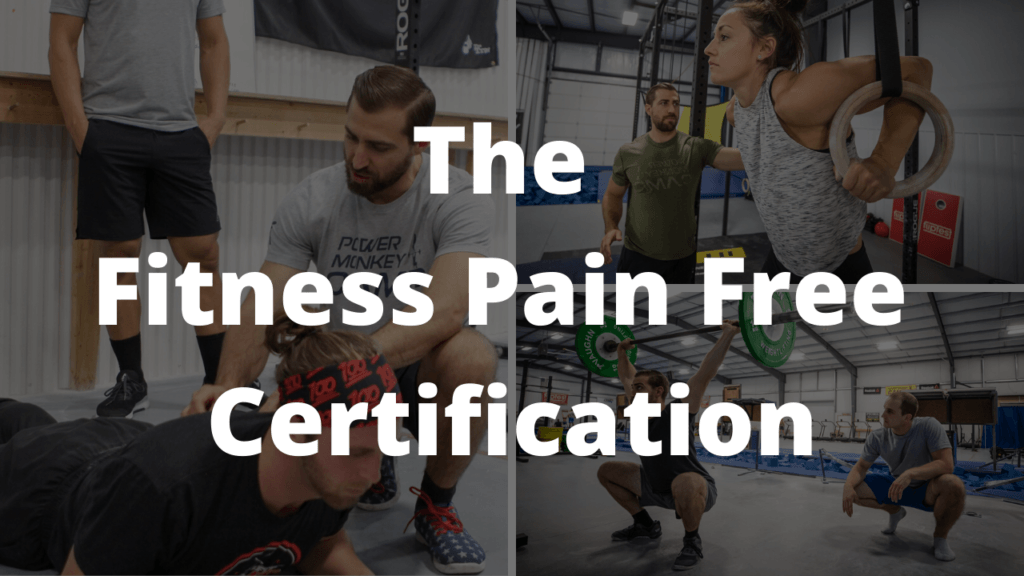
Updated: 9/10/21
Knee pain can be a huge problem for athletes who enjoying squatting and olympic weightlifting. To have success with injury we have to know how to modify training to keep progressing. This is vital because if we keep blowing through pain we can easily worsen the situation.
Trouble is, if we want a shot at getting back to train pain free in the future we actually have to stress the knee to have it improve. Most physical therapists are pretty adept at the beginning stages of rehab and can do a decent job of getting our athletes to a pain free level with regular activities.
The hard part is getting people back to intense training that really challenges the knee to a high level.
What’s good about this situation is that if we understand what technical factors increase and decrease stress on the knee we can easily dose our exercise prescription. This way we can start with a low level of stress early on in the rehab process and keep dosing up as the knee improves and we’re back to high level training.
First we’ll need to understand technical factors that increase stress on the knee joint. Check out the video below to see what I’m talking about:
Let’s recap and review what variables influence stress on the knee:
- The degree of knee flexion
- Increased squat depth increases stress
- Decreased squat depth decreases stress
- The degree of quad activation:
- Anterior weight shifting over the ball of the foot increases stress
- Posterior weight shifting over the heel decreases stress
- Higher loads (more weight) increase stress on the knee
- Lower loads (less weight) decrease stress on the knee
- Higher speed of execution (explosive lifts) increase stress on the knee
- Lower speed of execution (tempo lifts) decrease stress on the knee
- Torso angle (directly affects knee flexion and quad activity)
- More torso inclination (bent forward) decrease stress on the knee
- Less torso inclination (more upright squat) increase stress on the knee
- “Knee In” or valgus increases stress on the knee
So exercise is the medicine that allows injuries to heal. Our goal is to find the right dosage of exercise to help people recover over time. Now that we understand what influences stress on the knee we can use these guidelines to start dosing the knee with exercise.
I like to use pain as a guide to determine how much stress we apply to the knee during rehab. My general guidelines for pain during exercise are:
- Pain should be minimal or at or below a 3/10 on a 0-10 pain scale during exercise
- Pain levels should return to baseline following exercise and the following day
- Pain and function should be improving on a weekly and monthly basis
So in the beginning stages of rehab we want low degrees of quad activation and knee flexion. This keeps knee stress low. We’ll use a lot of partial range of motion training and slow speeds of execution:

In the program above you can see we’re using minimal knee bend on our olympic lifts. Our squatting is partial range with a tempo and our single leg strengthening is also partial range with a tempo.
On top of this we’re thoroughly training the core, hip and calf since both of those are beneficial in knee pain. I’ll generally have my athletes spend 2-4 weeks in this phase and after that we step it up a notch…

In this stage we introduce power variations of the olympic lifts and start pulling these reps off the floor. This adds a component of extra knee flexion and ramps up stress from phase 1. We’re also introducing deep loaded squats back into the program in preparation for next month when we add full range squatting back into the olympic lifts.
We’re also adding knee flexion and load to our single leg strength work and ramping up the core, hip and calf strength. As the knee continues to improve we step things up a notch…

In phase 3 we’re adding the squat portion back into our olympic lifts. We’re not quite catching at end range but we’ll probably be ready for it next month. We’re also back to full range and full speed front squatting which closely mimics the knee stress in the olympic lifts.
Our single leg strength has again increased in load and also range, this month adding a deficit to our lunge variation. As always the core, hip and calf strength also increases in intensity as well. After 4 weeks of this program our athlete is probably ready to be ramped back into their normal training. (pending they aren’t following a training program with super amounts of volume and or intensity)
So there you have it! That’s how I go about writing a knee pain program in a nutshell. The important point here is that if you understand the principles behind what stresses the knee you can go about designing a training program for your athletes to help get them back to the training they love.
The information I just went over is part of a much larger and more comprehensive program called “The Fitness Pain Free Certification”. In the program I go over exactly what to be on the lookout for to keep your athletes moving safely and efficiently in the gym and how to get them back to training after an injury. Learning how to write training programs for your athletes with all sorts of pain problems (knee, shoulder, lower back and hip) is a huge part of what you’ll learn in the certification as well.
To give you a taste and help further your knowledge I’ve made an entire mini course that you can check out right now for FREE. In the mini course we go over:
- Why We Need a Better System
- 7 Reasons Why Athletes Get Hurt in the Gym
- 4 Simple Steps For Getting Your Athletes Out of Pain and Optimizing For Long Term Success
I’ve even created a nice infographic to help you quickly and easily consume the most important information:
If you’re interested in learning more about how to rehab athletes in the gym and how to keep them safe for the long haul then signing up for the free mini course and infographic is the next logical step.
Click HERE to Sign Up for the FREE Fitness Pain Free Mini Course
All Kipped Out,
Dan Pope DPT, OCS, CSCS

